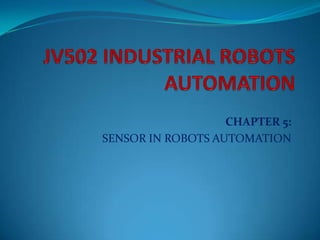
Chapter5 sensors of robots automation latest
- 1. CHAPTER 5: SENSOR IN ROBOTS AUTOMATION
- 2. Learning Outcomes: Upon completion this chapter, student should be able:- 1. State the categories of sensor 2. Explain the velocity sensors, acceleration sensors and the position sensors. 3. Explain the application of robot sensor in industries
- 3. Contents 1. Introduction of robot sensor 2. Velocity and acceleration sensors 3. Position sensors 4. Application of robot sensor in industries
- 5. Introduction of robot sensor Sensors are devices that can sense and measure physical properties of the environment e.g. temperature, luminance, resistance to touch, weight, size, etc. A robot needs sensing to be an active participant in the environment. Each sensor is based on a transduction principle, i.e. a conversion of energy from one form to another.
- 6. Classification of sensors Proprioceptive (“sense of self”, internal state): Measures values internally to the system (robot), e.g. battery level, wheel position, joint angle, etc. Exteroceptive (external state): Observations of robot environment, objects in it. Active: emit energy in environment More robust, less efficient Passive: passively receive energy from environment Less intrusive, but depends on environment e.g. light for camera
- 9. Sensor Characteristics Dynamic range: Ratio between lower and upper limits, usually in decibels. Range: Difference between min and max. Resolution: Minimum difference between two values. Linearity: Variation of output signal as function of the input signal. Bandwidth or frequency: The speed with which a sensor can provide a stream of readings. Sensitivity: Ratio of output change to input change. Error/Accuracy: Difference between the sensor’s output and the true value.
- 10. Velocity and Acceleration Sensor Velocity sensors: Used for medium to low frequency (1 to 1000 Hz) measurements. Act as a low-pass filter (reduce high frequency signals) Traditional velocity sensors employ an electromagnetic sensor to pick up the velocity signal Acceleration sensors: Used for the highest frequencies (100 Hz and up) Three types of accelerometers: piezoelectric strain gage ( piezoresistive) servo accelerometer
- 11. Tachometer A DC tachometer works in a similar fashion to the Linear Velocity Transducer, except magnet is fixed (“stator”) “coil” of wire rotates inside the magnet produces a voltage proportional to the angular velocity
- 12. Incremental Encoders Two sensors (usually optical) are mounted such that one is halfway blocked by the "solid" area (Channel A) while the other is in the middle of the "clear" area (Channel B).
- 13. Position Sensors Potentiometer Resolver Optical Encoders Relative position Absolute position Linear variable differential transformers (LVTD)
- 14. Potentiometer Resistance changes with the position of the dial potentiometers (“pots”) are electrical resistance elements made in both linearly & rotary form a mechanical motion of the wiper changes the output voltage in proportion to the wiper displacement
- 16. Resolver sensor Has a similar function principle as a stepper motor. It is a rotary electrical transformer basically implemented for calculating the degrees of rotation.
- 17. Wheel / motor encoders Measure position, speed, direction of revolution of the wheel. Odometry - wheel movements can be integrated to get an estimate of the robots position. Typical resolutions of 2000 increments per revolution.
- 18. Optical encoders Optical sensing of encoder position is used A light source (LED or light-emitting diode) is placed on one side of the encoder disk A light detector (phototransistor) is on the other side
- 19. Optical encoders Detecting absolute position
- 21. Linear variable differential transformers (LVTD) LVDT measures linear motion traveled as a voltage signal The sensor is based on the physical properties of transformers and electromagnetic induction The transformer coil construction consist of a primary winding between a pair of secondary coils on either side
- 23. Application of robot sensor in industries Various Types of Sensors for Robot Arc Welding Stations:
- 24. Figure 5(a) shows a contact type sensor A gas nozzle, or a finger, is used as a probe to detect contact with the work piece The nozzle senses the existence, location, and orientation, and, thereby, the location of the weld seam.
- 25. Figure 5(b) shows a non-contact type sensor referred to as a through-the-arc sensor This sensor detects changes of welding parameters while the torch is weaving during the arc welding process This type of sensor is appropriate for welding of bigger pieces with weaving when penetration control is not necessary.
- 26. Group Discussion Topic Industry Application of robot sensor in industries a. Types interfaces and groups of sensors used in industrial b. Primary simple contact sensor commonly found in robots automation system c. State non-contact sensor used in industrial system d. Difference between the simple sensor and complex sensor interface • Automotive • Semiconductor • Food
- 27. THANK YOU
